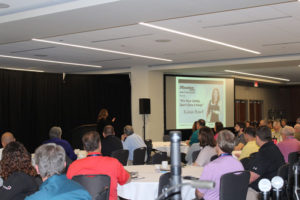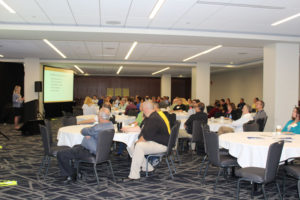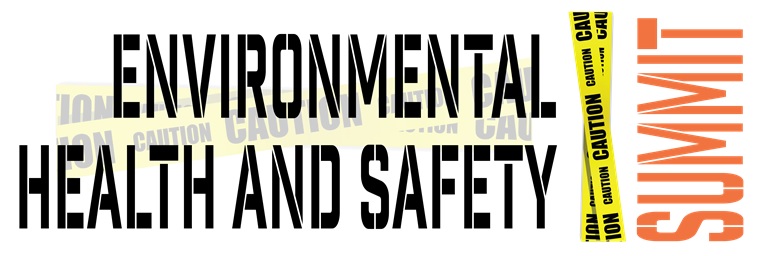 The 2019 Environmental, Health and Safety (EHS) Summit was held July 17 and 18 in Columbus, Ohio. The event was the largest to date, with more than 100 attendees gathering to share leadership and safety best practices with other manufacturing professionals. With a focus on world-class safety, over 25 industry safety speakers provided implementable ideas that attendees could use to improve their
The 2019 Environmental, Health and Safety (EHS) Summit was held July 17 and 18 in Columbus, Ohio. The event was the largest to date, with more than 100 attendees gathering to share leadership and safety best practices with other manufacturing professionals. With a focus on world-class safety, over 25 industry safety speakers provided implementable ideas that attendees could use to improve their
own operations.
Speakers stress preparation and prevention
 Keynote speaker Kina Hart offered a firsthand account of the importance of safety by recounting the tragic loss of her left arm in a conveyor belt accident. She described how lack of knowledge and training contributed to the day that forever changed her life. Driving home that the last line of defense is safety first, Hart encouraged active participation in safety while also discussing the effect injuries have on coworkers, family and friends.
Keynote speaker Kina Hart offered a firsthand account of the importance of safety by recounting the tragic loss of her left arm in a conveyor belt accident. She described how lack of knowledge and training contributed to the day that forever changed her life. Driving home that the last line of defense is safety first, Hart encouraged active participation in safety while also discussing the effect injuries have on coworkers, family and friends.
 Following the emotional keynote address, attendees had the opportunity to participate in roundtable discussions to grow their peer networks and exchange ideas on the most pressing EHS topics. Breakout sessions then provided a deep dive into relevant topics, including detailed information on the requirements for Tier II reporting; mill and calender operational safety, including a drill rescue video; issues arising from the legalization of marijuana in some states; fall hazard recognition and protection procedures; and monitoring and controlling air emission sources.
Following the emotional keynote address, attendees had the opportunity to participate in roundtable discussions to grow their peer networks and exchange ideas on the most pressing EHS topics. Breakout sessions then provided a deep dive into relevant topics, including detailed information on the requirements for Tier II reporting; mill and calender operational safety, including a drill rescue video; issues arising from the legalization of marijuana in some states; fall hazard recognition and protection procedures; and monitoring and controlling air emission sources.
In-depth articles on EHS Summit topics will appear in future issues of Plastics Business.
Automation Plastics Corporation
Description of Best Practice: Implementation of cultural change by enhancing physical appearance of the facility, while also improving and standardizing systems and procedures. Changes included upgrading older equipment on production floor, installing a new chiller system, adding new presses and lathe, installing security cameras, moving the Maintenance Department to a dedicated location, painting floors and walls throughout the building, adding new decor in offices and installing new signage outside.
Realized Results: Culture change happened. Personnel on all levels are involved with sharing ideas for improvement, cleaning up spills, putting away tools and organizing equipment. People are seeing safety issues more easily and reporting them sooner to management. We also are noticing safety issues are fixed within a short time of reporting. It’s easier to work in a clean, bright environment. We are tracking a downward trend in Incidents & Accidents, with zero slips or falls at the same level this year. Pride and positive behavior have helped us to become safer.
Intertech Plastics
Description of Best Practice: Although we have been working on improving safety from many angles, we feel that our investments in technology to improve forklift/pedestrian safety have had the biggest impact in demonstrating Intertech’s commitment to safety for its employees. These include wirelessly monitored forklift impact sensors that detect and report forklift impacts and send out operator performance reports so managers can reinforce safe operating behavior. Intertech also uses collision avoidance devices at all blind corners in the warehouse; LED forklift warning spotlights that are projected at 10ft in front/behind forklifts; and guardrails to define all pedestrian walkways within the facility.
Realized Results: Since making these improvements, we’ve received lots of positive feedback from employees and they’ve been more engaged and excited about wanting to continue to improve safety.
Currier Plastics
Description of Best Practice: By the end of 2017, our number of recordable and lost time incidents had plateaued, and we decided it was time to reevaluate our system. Safety had become something that happened but wasn’t a primary focus. We identified focus areas, including Leadership, Conditional-Based Safety, Behavioral Observation, Communication, Training, Incident Reporting, Recognition and Continuous Improvement. Within each area, we focused on how we promote engagement, use data to make decisions and make safety a part of the conversation within the facility on a day in and day out basis.
Realized Results: Currier Plastics recently broke our record for longest period of time without a recordable incident (previous record was 233 days). The safety committee is engaged and having the strongest turnout in years, and we have a high-level engagement as shown by the 550+ close call/first aid reports that have been submitted since the start of 2019. Our recordable injury rate is on pace to be the lowest in our history, and we continue to make significant improvements to our safety engagement and culture. We believe that placing the priority on safety that we have is a major part of what makes Currier Plastics a preferred employer as well as a preferred supplier to our customers.
PolyFlex Products
Description of Best Practice: Here at PolyFlex, we have discovered that the best way to improve and implement safety standards is to go and see the issues. We have a strong belief that you cannot solve problems behind a desk, and that you need to see where the issues are. Since we have implemented this mindset in the organization, we have more people engaging and noticing situations that could potentially lead to an accident. Once a particular situation has been identified, the department heads, the maintenance manager, possibly an HR rep and the plant manager get involved to put special attention on that situation. We work through the problem and come up with a firm plan to prevent the unsafe situation in the future.
Realized Results: Improvements that have developed from our best practices in our Safety Standard include the following: fewer accidents; standard forms and processes; more accountability (more accurate/precise safety plan); better predicting of safety issues; quicker response in implementing safety standards; tracking/updating of SDS sheets; more training videos, pictures and tests; and a more formal lockout/tagout process.
How to Survive an OSHA Inspection
Chris Whitehorne, U.S. Compliance
Employee complaints are the most common source of OSHA inspections. Typically, if a former employee registers a complaint, OSHA will send a letter to your facility. When you respond in a sufficient manner to that letter, OSHA closes out the complaint without an on-site visit.
However, if an active employee reports an imminent danger – such as entering into confined spaces without proper monitoring or working at heights above 12 feet without fall protection – and OSHA determines that there’s imminent danger to a current employee, that typically will trigger an on-site inspection by OSHA.
Many times, these complaint inspections occur because the employee has brought up the concerns at a safety committee meeting or to a supervisor, and they’ve fallen on deaf ears. Eventually, the employee comes to a point of being so disgruntled or concerned about their own health and safety that OSHA is notified. One of the biggest things an employer can do to eliminate the potential for OSHA visits due to employee complaints is to address employee concerns. Do they have complaints? If they are voicing them, are you tracking them? Are you addressing them in a timely manner? These are critical questions.
A Safety Professional’s Guide to Prepare for, React to and Address Workplace Violence Events
Scott Lowry, Three60 Response LLC
In the event of an active shooter situation, pre-planning must take place between the emergency responders in your community and your company. Some of the items to be addressed include the following:
Command post. Preestablish where those command posts are going to be. The fire chief is often the one to do that – to look at your facility and the surrounding area to make recommendations. Make sure the people from your organization who are assigned to the command post know where those locations will be so they can answer questions about the situation occurring and the facility.
Perimeter. Emergency responders will need to establish a perimeter around the building to keep people away – loved ones, media, normal traffic flow within the community. You may need to, in preplanning, assist emergency responders in helping to plan that perimeter area.
Rally points. The “run” part of “run, hide, fight” is that we want everyone to rapidly evacuate a facility. Rally points are for those people who become injured in running from the facility so medical aid can be given – and emergency services need to know where those rally points are located.
Lockout/Tagout and Machine Guarding Standards
Bill Wahoff and Nelva Smith, Steptoe-Johnson
If an OSHA compliance officer asks your employees if you have an energy control program, and all you’ve ever talked about is lockout/tagout, they might say, “no.” Keep terminology in mind. When you train your employees, if you don’t give them the right jargon, they might not recognize it in a private interview. Among the many requirements for lockout/tagout procedures, don’t forget these:
Periodic inspection. It is required – at least annually – that a review of energy control procedures is conducted. Document the step-by-step process that someone must go through to lockout/tagout each machine on the facility floor – and then list the steps to verify that the energy has been disconnected. If the lockout/tagout is not verified, operators can be injured.
Training. Training for authorized and affected employees – and all other employees whose work operations may be in an area where energy control procedures may be utilized – is vital. How often is training conducted? How many new people have joined the department?
Retraining. Retraining must be done whenever an employee has a change in job assignment and whenever new machines, equipment or processes that present a new hazard are introduced into the facility.
Emergency Planning 101
Matthew McCrystal, Ohio Emergency Management Agency
The Emergency Operations Plan (EOP) for any organization should contain all of the information necessary to appropriately respond to and recover from an emergency situation. This plan is just like a “go bag,” where all information is in one place and easily can be taken from the site of an emergency to the site where responders are gathered. Information to have on hand and ready to go includes the following:
- Recordkeeping / Important forms
- Pre-scripted messages
- Important phone numbers
- Facility and area maps
- Employee lists
When developing an EOP, don’t start from scratch – there are plenty existing resources and tools. FEMA (www.fema.gov) provides the Comprehensive Preparedness Guide – also known as CPG 101 – to walk novice and experienced planners through plan development with information, checklists and a list of questions to consider. Ohio Emergency Management (www.ema.ohio.gov) also offers several resources.





